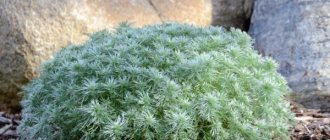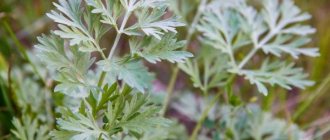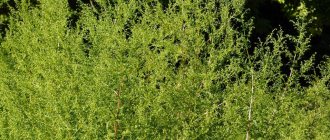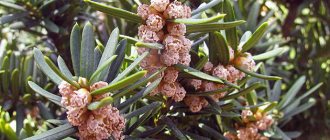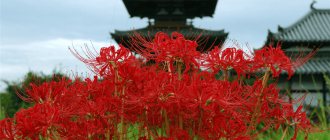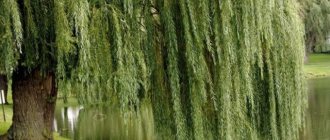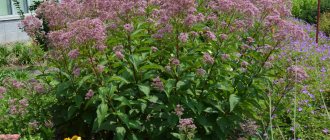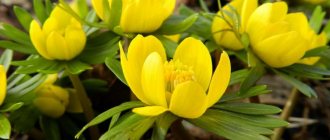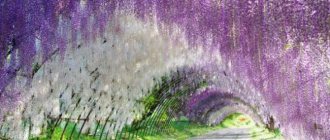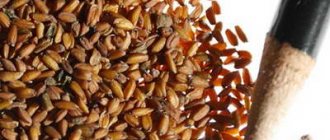The genus of wormwood or artemisia (Artemisia) from the Asteraceae family includes about 300 species of herbaceous and subshrub plants growing in the wild in Europe and most of Asia and North Africa.
The value of decorative wormwood for the garden lies in its unusual silver-gray foliage. The leaves of the plant are covered with thick silky hairs; inconspicuous yellow or white flowers appear in July-August.
There is a legend in Europe that the spicy smell of wormwood planted near a house can drive away evil spirits. We don’t know what about perfumes, but the culture perfectly repels mosquitoes on the site.
Several representatives of the genus are used as ornamental plants in landscape design.
Schmidt's wormwood (Artemisia schmidtii)
, namely its groundcover variety 'Nana', also known as 'Silver Mound', 10-25 cm high. The plant forms dense silver-green clumps with feathery foliage. It lends itself perfectly to pruning, thanks to which you can form compact, lush pillows. In winter it can freeze slightly, but recovers quickly. A spectacular hybrid of this species, “Powis Castle,” about 35 cm high with openwork pinnately dissected foliage.
Steller's wormwood (Artemisia stelleri)
and its varietal forms “Mori's Form” and “Boughton Silver” with silver-white openwork leaves. The height of the varieties is about 30-40 cm.
Louis's wormwood (Artemisia ludoviciana)
. Its height is 50-80 cm. Narrow leaves are gray or silver in color. Well-known varietal forms “Valeri Finning”, “Silver Queen”, “Silver King”.
Wormwood Pursha (Artemisia purshiana)
. A herbaceous semi-shrub plant with a branched stem 60-70 cm tall and elongated oval white-gray leaves. Regular pinching of the top during the growing season allows you to form a beautiful lush bush.
The culture is completely undemanding to care. Wormwood in the garden grows well in full sun. Loves poor, well-drained soils; in fertile soil it loses its compact shape. Like most silver-gray deciduous plants, artemisia is very drought tolerant and does not tolerate stagnant water, which causes the plant to die. However, immediately after planting, it requires regular moderate watering for 2-3 weeks to take root.
Since the crop grows well in poor soils, it does not need fertilizing at all. Throughout the season, caring for wormwood in the garden consists of weeding and pruning shoots in autumn or spring for tall species. Low varieties that form clumps eventually begin to die off in the center, so every 2-3 years they need to be rejuvenated by division. The procedure is carried out in the spring.
The plant propagates mainly by dividing bushes, root or stem cuttings, but the first method is the simplest and most effective. Artemisia can be susceptible to fungal diseases such as powdery mildew, mold, and white rust. High humidity and poor air circulation exacerbate these problems.
Application in landscape design
In the garden, wormwood looks advantageous in a composition with graceful, blue, lofant, bright carnation grass, sunny, echinacea, variegated varieties of dwarf barberry, euonymus,
Kira Stoletova
The aromatic weed Steller's wormwood is today used as an ornamental plant for landscape design in gardens and summer cottages. There are several species that are planted to create compositions; caring for Steller's wormwood does not require any special costs.
Types of wormwood
The plant belongs to the order Asteraceae, the family Asteraceae (Asteraceae), and the genus Artemisia. The Latin name - Artemisia (artemisia) - is given in honor of the ancient Greek goddess Artemis, whose symbol this herb was considered. Different peoples give wormwood other names. For example, the Turkic name is Yevshan or Chernobyl (bitter star).
The genus includes more than 400 species, 170 of them grow in Russia and in neighboring countries of Asia and Europe. There are widespread and rare varieties. Some of them are cultivated as ornamental or medicinal, for the production of medicinal products. The plant blooms and has original leaves, which is why it is becoming increasingly popular among landscape designers. Wormwood began to be often planted in city flower beds and in flower beds near houses.
Species are conventionally divided into tall and short. Tall ones reach 1-2 m, have a bushy stem, grow on plains and steppes. Low-growing ones do not grow more than 20-40 cm; they are common in mountainous areas with poor soil.
Known tall varieties:
- ordinary;
- bitter;
- gmelin;
- Louisiana;
- milky-flowered;
- annual;
- rutifolia;
- lemon;
- tarragon (tarragon);
- spreading;
- Djungarian;
- citvar;
- medicinal (fragrant).
Popular low-growing species:
- Schmidt;
- Steller;
- field;
- shiny;
- cold (stone);
- white earth;
- few-flowered (black);
- Tauride;
- Austrian;
- Caucasian;
- broadleaf;
- dwarf.
Wormwood, whose range is the entire Northern Hemisphere, also covers South Africa. The distribution is wide, it is found everywhere. Loves open areas. Kazakhstan and southern Ukraine are known for their entire thickets. The plants are unpretentious and grow even on the poorest soil or rocky soil. They inhabit wastelands, rocks and mountains.
Lemon wormwood grows at higher elevations in Central Asia. This plant was described in the 20s of the last century. Now the lemon-scented herb is grown in flower beds.
Not only lemon wormwood is endemic. Gmelina grows in the Far East; it is not found anywhere else. Tauride is found only in the Crimea and in the steppes of the southern regions of Ukraine.
Sagebrush
Just recently, at the mention of this plant, the owners of garden and vegetable plots sternly pursed their lips and angrily raised their eyebrows to the bridge of their nose, because not everyone knows about the non-weed species of wormwood. Some of the varieties of this plant are very decorative and are quite often used in landscape design.
1 – Wormwood Pursha; 2 – Steller’s wormwood; 3 – Louis wormwood; 4 – Schmidt’s wormwood
Wormwood Pursha . An actively growing species with long pointed leaves. The height of Pursha wormwood can reach 60 cm, but if you wish, you can always remove the extra centimeters, because This plant tolerates pruning very well.
Steller's wormwood . Its decorative effect is expressed not only by its silver color, but also by the openwork shape of the leaves. Relatively low (20-30 cm) outstretched shoots quickly grow and lie down over time. Unlike most types of wormwood, it does not have a rich aroma. An excellent option for those who do not like wormwood because of its specific smell.
Wormwood Louis . This species can be called tall, because. under favorable conditions, its compact bushes can grow up to 60-80 cm. This allows you to use Louis wormwood to decorate the background. It lends itself well to shaping, but has a pronounced wormwood aroma and therefore is not suitable for everyone.
Schmidt's Wormwood . A compact plant 20-30 cm high forms dense spherical bushes. The leaves of Artemisia Schmidt consist of many thread-like lobes, which makes them even more graceful.
Description of the plant
All varieties of wormwood are similar to each other
Wormwood looks like a small bush with small dissected leaves and inconspicuous flowers. Different species differ from each other, but the genus has a number of common characteristics and a similar structure:
- The stem is thick, hard, straight, sometimes looks like a tree.
- The leaves are separate, palmate or pinnate, in most species they are dissected with small lobules, but they are entire or entire.
- The lower leaves are larger than the upper ones, sessile.
- All green parts of the plant are covered with silvery fibers, which is why wormwood is gray.
- The roots are thick.
- Wormwood flowers are inconspicuous, small, white or yellow; reddish ones are less common.
- Inflorescences are small heads or baskets with an ovoid, spherical or cup-shaped shape, up to 1 cm in size, wrapped in thin imbricated sepals. Along the edges there are unisexual pistillate flowers (in the subgenus Draclinculus - staminate), in the center - bisexual. They have tubular shapes and small diameters.
- Inflorescences of the first order are collected in racemes, panicles, and spikelets.
- During the flowering period, pollen is carried by the wind; insects do not participate in pollination.
- The fruit is a smooth seed. One bush is capable of producing more than 100,000 fruits per season; the seeds of any wormwood are spread by the wind, and it sows large areas with its seedlings.
Most species are biennial or perennial plants, less often annuals. In the first year, green runners grow from the roots of two-year-old grass. The flowering of such wormwood begins in the next season, and flower stalks appear. Most often, this period in the temperate zone falls at the end of summer and beginning of autumn. Annual and perennial varieties produce flowers annually.
This herbaceous shrub has a sharp and specific odor; the juice contains bitterness. Mice and insects are afraid of its blooms; many herbivores do not eat this plant. There is a sign: if you find the first wormwood in the spring and pick it with your own hands, all your troubles will go away.
Where and how does it grow
The medicinal plant is widespread throughout Europe (with the exception of northern taiga, tundra and semi-desert areas), as well as in the southern part of Siberia (up to the Yenisei) and the Caucasus.
This bitter herb grows along roads, in vegetable gardens, in orchards, in pastures, and sometimes it can be found on forest edges, meadows or coastal slopes.
Wormwood blooms (see photo of flowering below) in the period July-August, and the seeds of the plant ripen in August-October.
The collection of bitter wormwood is done during the flowering period.
Chemical composition
The chemical composition of the plant is rich; it is a real storehouse of useful elements. The leaves contain substances that give the plant bitterness. Most of them are found in bitter wormwood. It contains biologically active components that have different effects on the body:
- flavonoids;
- thujone;
- pinene;
- cadinene;
- bisabolol;
- hamazulengon;
- selinene;
- capillin;
- Apple acid;
- succinic acid;
- alkaloids;
- saponins;
- terpenoids;
- galenic compounds.
The plant is rich in phytoncides, famous for their bactericidal effects, and contains ascorbic acid, carotene and vitamin A. Thanks to this rich composition, wormwood has been used for medicinal purposes for many centuries.
Application
In cooking
In medicine
Nowadays, wormwood is very popular among admirers of traditional medicine, who claim that the medicinal properties and contraindications of widow's grass are amazing, since one spoon of dried wormwood leaves contains such an amount of useful substances that are not found in any medical preparation. It must be admitted that this plant has found application in many areas. Wormwood is actively used to combat ailments:
In gardening
In gardening, wormwood infusions are prepared to combat leaf-eating caterpillars. To prepare such a solution for spraying plants and trees, you need to measure out 1 kg of fresh crushed wormwood, then boil it in a small amount of water for 10-15 minutes. After this, it is necessary to infuse the decoction and strain, and then use it for its intended purpose.
In cosmetology
Bitter wormwood is actively used in natural cosmetology.
Warts
Grind 200 g of dried wormwood thoroughly, and then pour in 200 ml of boiling water. Boil the herb over low heat for 20 minutes. We keep the broth in a warm place for 2 hours, after which we filter it and lubricate the areas with warts every day 5-6 times.
Oily skin
Powder 50 g of wormwood into powder and pour 400 ml of boiling water. Bring the broth to a boil, then simmer for 10 minutes over low heat. Cool the medicine and strain. Rinse clean facial skin until it is no longer oily.
Medicinal properties
The herb has a beneficial effect on the entire body
Wormwood is most often used for medicinal purposes. Some other species also have medicinal properties. The use of extracts, tinctures and decoctions increases appetite and treats gastric diseases. Bitter substances irritate the papillae on the tongue, which stimulates the secretion of pancreatic enzymes, bile, gastric juice and increases acidity. Digestion improves, and the whole body begins to work better.
Alkaloids and some other substances have a beneficial effect on the functioning of the heart. Chamazulene activates immune cells - phagocytes and lymphocytes. The plant has an antimicrobial and anti-inflammatory effect, improves the immune system. The combination of chemical compounds contained in the grass can destroy parasites, which is why it is used as an anthelmintic.
Indications for use of wormwood:
- hypoacid gastritis and ulcers due to low acidity;
- dyspepsia;
- biliary dyskinesia;
- constipation;
- flatulence (bloating);
- dysentery and other intestinal infections;
- liver diseases;
- ulcerative colitis;
- haemorrhoids;
- colds, flu, ARVI;
- bronchial asthma;
- rheumatic diseases;
- skin eczema;
- burns of various etiologies;
- hypertension;
- migraine;
- neurasthenia;
- wounds and bruises;
- sprain.
Chinese medicine uses wormwood as an aphrodisiac. In Europe, it was added to many medicinal tinctures. Even 200-300 years ago, polynotherapy was considered a panacea. Wormwood extract was one of the most valuable medicines. Tarragon and wormwood are widely used in homeopathy.
Mages believed that wormwood contained great vital energy. Even now, fumigation or spraying of houses and apartments is used to change its energy in a positive direction. This herb is a good protection and amulet from damage and the evil eye.
Wormwood herb is contraindicated for some people. It should not be drunk during pregnancy or breastfeeding. Many components are toxic in large doses; you should not overuse tinctures; they are drunk only in the quantities indicated in the recipe. When mixed with large doses of alcohol, the plant causes side effects - hallucinations, convulsions.
General information and some types
The wormwood plant is a herbaceous perennial from the Astroflower family. The plant has branched roots that are covered with silvery fluff. It has straight stems on which dissected leaves are densely located.
There are more than four hundred species of wormwood in the world, and each of them has invaluable properties. Citvar and bitter wormwood are used for medicinal decoctions and infusions; bitter wormwood extract is very often used in perfumery and even in the production of alcoholic drinks such as absinthe and vermouth. Spreading wormwood is fed to domestic animals. Many species serve as excellent soil fixers. Tarragon wormwood, better known as tarragon or tarragon, gives dishes an unusual aroma and magical taste.
The use of wormwood in landscape design is also very common. The following types of wormwood are perfect for poor sandy soil:
- milky-flowered,
- Stiller,
- Schmidt,
- Ludvika,
- Pontic,
- Persian,
- Armenian
Wormwood Louis
This cultivated plant is native to Seven Americas. Ludoviciana, as it is also called, is a perennial. This ornamental plant reaches a height of 80 centimeters and has a very developed and long root system. Its stems are densely pubescent and very strong; they bear silvery leaves. In order to form a compact Louis wormwood bush, you need to regularly pinch out new shoots and remove inflorescences.
Any garden will be decorated with varieties of Louis wormwood:
- Valeri Finnig. This is a shrub with dissected leaves and uneven stems. The leaf is greenish-gray on the outside and white on the inside.
- Silver Queen. This bush is more branched and densely covered with foliage.
Wormwood Schmidt
This is a perennial that is quite densely covered with lacy silvery leaves. The height of the plant can reach 15-30 centimeters. This is a very popular type of wormwood that looks great in a landscape ensemble with other plants and flowers. The most popular variety of Schmidt's wormwood is Nana. A compact bush in the shape of a ball with thread-like dissected leaves has a simply stunning appearance.
Steller's Wormwood
This plant is very popular due to its beautiful lacy leaves. They give the plant extraordinary beauty. The silvery leaves remain decorative throughout the season, grow in the spring and at the same time exude a specific pleasant aroma.
Although the plant blooms and this happens in mid-July, its flowers are not of particular value for the appearance of the bush. It is generally recommended to remove flowers, as they cover the plant itself. The leaves, very similar to deer antlers, seem to spread across the soil, and such a miniature and very neat plant looks simply stunning in any garden.
This variety goes very well with bright flowers - phlox, herbal carnation and yarrow.
Healthy recipes
Drops, alcohol tinctures, and dry preparations based on wormwood are sold in pharmacies. There are many traditional medical recipes that are used to treat various diseases. Wormwood is popularly considered an excellent remedy for stomach diseases. This is a feminine herb, which is why it is recommended to drink it for gynecological diseases. It thickens the blood, relieves pain, reduces fever, helps get rid of acne and condylomas, and even impotence in men.
Recipes with wormwood are simple and easy to prepare at home. In addition to classic decoctions and infusions, ointments, compresses, and alcohol tinctures are made from this herb. To prepare the products, flowering wormwood, leaves, seeds, and roots are used. To prevent medications from causing harm, you should follow the instructions for use.
Infusions for the stomach
Wormwood infusion increases appetite
Take 2 tbsp. l. dried or fresh wormwood, pour 2 cups of boiling water and place in a water bath for a quarter of an hour. After this, remove, cover and leave for another 45 minutes. Strain, drink three times a day, 1-2 tbsp. l. half an hour before meals. It is recommended to store the product for no longer than 2 days. It is taken with soda. Sometimes the decoction is recommended for children to increase appetite. But wormwood can be dangerous, so it is better not to use it before the age of 12.
For gastritis and low acidity tsp. pour a glass of boiling water over the herbs and leave for 20 minutes. Drink half a glass in 30 minutes. before meals. The product helps with stomach pain. Take it one and a half hours before meals. Adding dill seeds, St. John's wort, calamus root, flax, and peppermint to the broth can enhance the effect. For constipation, the collection includes senna, which enhances peristalsis and thins the stool.
Reproduction
In the process of care, reproduction is important, through which the planting area is increased. The root system of the plant is formed in the form of a thick creeping rhizome, used in the process of propagation of garden crops
Steller's wormwood is also propagated by cuttings and by dividing the bush.
Reproduction by cuttings
When propagating Steller's wormwood by cuttings, a large mass of planting material is obtained. The procedure is carried out during the period of active growth of the bush, which usually occurs in May-June. Young and last year's plants, including the tops and central part, are suitable as a source for propagation.
Cutting process:
- the source material is cut into small pieces (cuttings) of 8-10 cm;
- the lower cut is made at an angle, which makes it possible to subsequently determine the top and bottom of the planting material;
- prepare soil from sand and humus;
- plant cuttings to a depth of 3-4 cm, maintaining a distance between seedlings of 5-8 cm;
- the top of the planting is covered with glass or film, which speeds up the process of formation of the root system;
- 2 weeks after the roots appear, the covering material is removed.
Further care of the seedlings comes down to moderate watering. They are planted in a permanent place of growth for the next season.
10 plants for poor soil Flowers How to grow flowers
Root propagation
Artemisia stelleriana is often propagated by rhizomes, which makes it possible to quickly obtain new seedlings. Propagation begins in April or August:
- dig up the bush, releasing the roots;
- cut off the root part;
- the cut off area is divided so that each part has 1-2 buds;
- the cuttings are planted in a permanent place of growth.
Other uses of wormwood
Wormwood is used in the production of alcoholic beverages
Different varieties of wormwood are used not only for medicinal purposes. They are widely used in cooking and the production of alcoholic beverages. The tarragon variety is included in the popular soda tarragon. The famous drink absinthe is made from this herb. It contains about 15 components: anise, coriander, parsley, mint, calamus, fennel, chamomile, speedwell, licorice, lemon balm, etc.
It is believed that thujone, which is part of wormwood, is a drug-containing compound that causes poisoning, hallucinations, and schizophrenia. For a long time, the drink was banned in many European countries; people received prison sentences for its production and possession. But to date there is no evidence that this particular substance provokes undesirable effects. Since the end of the last century, absinthe began to be produced and sold again. Czech-made bottles were the first to appear on the market, then they began to be made in Britain, France and other countries. The thujone content was limited to 35 mg/kg (in the USA - to 10 mg/kg).
Essential oils and extracts are used in perfumery. For the production of perfume, aromatic lemon and tavriche wormwood is used. The strong smell of the grass repels insects and parasites. It is used against fleas, bedbugs, lice, mosquitoes, aphids, cockroaches and even mice. They hang a broom in the house, spray the corners or scatter grass around the apartment, and try to fumigate the room. The plant does not kill pests; treatment only prevents their appearance in the house.
Use of decorative wormwood
Most types of wormwood are used as decorative foliage plants in plantings, and Steller's wormwood is used in borders.
In gardening, wormwood is used for its silvery, lacy foliage, which, together with purple, white and blue flowers, gives the composition an airy feel. These plants are decorative all summer. Tall species of wormwood are planted in flower beds to soften the colors.
Wormwood responds well to cutting; they can be used to form compositions of different heights. Decorative wormwood goes well with some plants. You just need to choose the right combinations.
Wormwood in agriculture
Wormwood is a valuable animal feed. It is eaten by sheep, horses, goats, and camels. In areas where there is little vegetation, grass becomes the only food in winter and early spring. But not all animals accept wormwood well; it should not be given to rabbits, and cows and geese themselves avoid the thickets. Only in the spring, when there is a lack of vitamins, cattle eat the bitter plant. Because of this, the milk tastes bad and smells bad.
In beekeeping, medicinal varieties are used to treat certain insect diseases. For example, the plant helps to destroy small mites that settle in the hive. Flowering wormwood is also included in fumigation mixtures during the honey harvest.
For many people, wormwood is a common weed, like quinoa, that is difficult to control in the fields. But the roots of this plant strengthen the sandy shores. If grass takes up residence in vacant lots, it crowds out other vegetation. It often grows in old landfills or quarries, contributing to their reclamation.
How to propagate wormwood?
Buzulnik przewalski: description, planting and care
Usually, to propagate a dill tree, it is recommended to use the vegetative method - dividing the bush, cutting and rooting sections of roots and seeds.
- Reproduction of wormwood by seeds.
This method is quite easy. Suitable for sowing in both spring and autumn. You can grow seedlings or immediately sow seeds with the arrival of April or in the first week of May in the garden bed, creating greenhouse conditions. The soil should be loose and light, but not too fertile, so that the top layer of soil exceeds 20–40 cm. When planting directly into the soil, the row spacing is maintained at 15–20 cm. The furrows form a shallow depth. The seeds are placed in them, but not embedded, or it is recommended to sprinkle them with a layer of substrate no more than 0.5 cm. After 2–3 weeks, you can see the seedlings and start thinning them, so that the distance between the remaining specimens is 10–15 cm. When When spring comes next year, then in April-May you can transplant the seedlings to a permanent place in the garden throughout the summer months until the beginning of autumn. When the plants are fully established, it is recommended to water them with a solution infused with chicken droppings. Typically, the seed method is used for annual species. - Reproduction of wormwood by cuttings.
The best time for this is from May to July. In this case, you can obtain numerous seedlings as a planting stock. For the preparations, it is recommended to cut the tops of the shoots 10–15 cm long and plant them in a sandy soil mixture mixed with humus (the proportions are equal). To avoid confusion when planting, it is best to make the bottom cut of the workpiece obliquely. Planting is carried out in a container approximately 25–30 cm deep or in a greenhouse. The planting depth should be 3–4 cm with a distance between cuttings of about 5–8 cm. After planting, abundant watering and shelter are needed. For this, glass or plastic containers and frames are used. It is also worth taking care of shading using matting or mats. Rooting occurs in about 10–15 days, and then the seedlings are transplanted to a permanent place in the garden, or you need to wait until the next growing season. - Propagating wormwood by dividing the bush
is also not difficult. The time for manipulation is selected in the spring and summer. Then the plant is removed from the soil and its root system is divided into parts. Afterwards, you need to plant the cuttings in the prepared place and water them abundantly.
Common wormwood descriptions and photos of the plant
Botanical name: Artemisia vulgaris, mugwort
Wormwood is a tall herbaceous perennial belonging to the Asterceae (Compositae) or daisy family. It can grow up to 1.5 meters and is supported by a strong root system. The leaves are dark grey-green, lobed and 5-20 cm long. They have silvery gray-white fluff on the underside, with straight stems showing a purple tint. The flowers appear in summer and are not very large and radially symmetrical, with many red and yellow flowers held in panicles or groups from the same stem. Unopened flowers have the shape of a small white ball. Male and female flowers are born on the same plant.
Artemisia vulgaris is often identified in herbal writings as wormwood. However, the correct botanical name is Artemisia absinthium. Other common names include cheating grass, chrysanthemums, wild wormwood, old Uncle Henry's grass, maggon, moxa, sailor's tobacco, and St. John's grass (not to be confused with St. John's wort). The name "wormwood" is often mentioned in the traditions of aromatic drinks (kept in mugs) since the Iron Age. However, an alternative suggestion is that the name comes from "moth" meaning moth or larva, due to the value contained in holding moths.
Common wormwood is native to temperate regions of Europe, Asia, North Africa, Canada, Alaska, and is naturalized in North America, where it may be considered a weed. It is often found in nitrogen-rich soils such as cleared urban areas and roadsides where there is little vegetation. Some moths and butterflies rely on this plant in their natural habitat, so it can serve as a good insect attractant.
Wormwood in nature and in the garden
All wormwoods belong to the extensive genus Artemisia, numbering about 400 species, and belong to the Compositae family. Among them there are annuals, but most wormwoods are subshrubs and herbaceous perennials with a woody base. They are widespread throughout the Northern Hemisphere, but are mainly confined to steppe and foothill regions, open sunny places, sandy and rocky soils.
Wormwood in a rocky garden
It is this ability to grow on light, infertile and waterless soils, under the scorching sun and piercing wind that has developed in plants a kind of protective reaction: the leaves, and often the stems (in herbaceous species) are densely pubescent and covered with tiny hairs, which is why they are so valuable in decorative purposes. respect silvery patina. Different species have it to varying degrees, but all wormwoods are characterized by bluish or gray shades . Breeders select specimens with the most pronounced pubescence or specially cut leaves.
Wormwood in the heather garden of the Prague Botanical Garden
Over time, wormwood migrated to flower beds from monastery gardens and vegetable gardens, where they were grown along with other aromatic and spicy-flavoring plants, and with the spread of fashion for natural gardens, interest in them grew noticeably. Today, no one is surprised by the presence of wormwood in our ornamental gardens. It’s just a pity that not everyone has yet been able to appreciate their excellent potential in garden design, because there are not so many plants with such amazing silvery leaves.
Wormwood in John Brooks' Garden
Gray and silver shades fit perfectly with all other colors, highlighting them and coordinating them. They can soften too obvious and sharp contrast, create a gentle tone for pastel colors and add elegance to dark ones. Against the background of gray, green will sparkle in a new way. Silver can add depth and lightness to tight plantings and heavy color combinations. Both warm and cold ones next to them will appear in an equally advantageous light. If we add to these undoubted advantages the stunning texture of many garden wormwoods - the finest silver openwork - it becomes obvious that they simply have no competitors.
You can choose wormwood for your garden in our catalog, which presents offers from various online stores of seeds and planting material. View a selection of wormwood seeds and seedlings :
Wormwood grass is a whole group of plants that are distributed throughout the Northern Hemisphere. They are found in wastelands, meadows, and steppes, and often infest vegetable gardens. Many species are useful for humans and are used in medicine, cosmetology, and cooking. There are varieties that are grown in flower beds in gardens.
Growing conditions
Artemisia vulgaris prefers sunny, moist but well-drained soil. She does not like wet soil, but dry soils give good results. A shaded "wooded" position is also satisfactory. It can tolerate many soil conditions, including alkaline soil, with a hydrogen weight range of 4.8 to 8.2. It is known that it can grow well in soil with high nitrogen content. The established plants are hardy and drought resistant.
Interestingly, they can be smaller in size, but longer-lived and more aromatic when grown in poor soil with dry conditions.
Common wormwood grows by spreading roots, so determine where you want the plant to grow and trim or remove roots as needed. An interesting aspect of the plant is that the roots release chemicals that can inhibit the growth of other plants. This is something to be aware of when choosing garden buddies for wormwood and tomatoes. If you have any doubts about this or the spreading root system, it can grow well in a larger container.
Basic cuttings can be taken in the spring and planted after the risk of frost has passed. Separation from the greenhouse should be carried out in spring or autumn.
For additional herbal uses, the leaves and stems can be collected before summer bloom and hung upside down to dry. The roots should be collected in the fall, washed and laid out until dry to prevent mold from developing as they come into contact.
Wormwood Schmidt Nana: planting and care, photo
Wormwood Schmidt Nana is an ornamental plant.
It grows from early spring to late autumn. It is used in landscape design of park areas and urban areas, as well as in private gardening. Wormwood Schmidt Nana
Characteristic
Artemisia Schmidt is a species of wormwood that comes from the Far Eastern region of Russia and Japan. In garden culture, a variety called Nana, known as Silver mound, is used.
This is a small hemispherical semi-shrub with shoots growing in a vertical direction, densely covered with foliage.
The leaves of Artemisia Schmidt Nana are thin and narrow silky hairs of a bluish or green color with a silver tint, they are pinnately dissected and densely pubescent.
The advantage of growing Schmidt's wormwood bush in open soil is its rapid growth, which makes it possible to improve the area in a short period of time.
Wormwood shoots form a rounded bush or dense clump growing up to 0.3 m.
The paniculate inflorescences of Schmidt's wormwood grass are located on erect peduncles and are formed by small yellow or light yellow flowers. The flowering period is from August to September.
Landing place
Schmidt's wormwood is not demanding on soil quality; it develops fully on poor soils, but with good looseness, and in fertile soils it loses its compactness and grows quickly. Growing in a natural environment in semi-desert and desert, the semi-shrub is a drought-resistant and winter-hardy plant. The selection of soil depends on the type:
- when planting the silver wormwood variety Schmidt, peaty acidic soil is not recommended; it grows well in poor, neutral soil with a well-organized drainage system;
- The green foliage varieties of Artemisia Nana grow in fertile, moist soil.
For planting silver wormwood Nana, the best place is one that is well lit by sunlight; species with green foliage love shade.
Features of planting and care
Shrub needs pruning
In the process of planting Schmidt's wormwood, river sand is added to the planting hole, which gives the soil the looseness necessary for the subshrub. Additional organic matter provides the plant with better survival.
Watering is carried out rarely, mainly in hot, dry weather.
With increased soil moisture and frequent watering, Schmidt's Silver Mound wormwood acquires a more saturated green hue and at the same time loses its pubescence, losing its decorative appeal.
Wormwood bush grows in open space with great intensity, so in the process of caring for it, it is worth regularly trimming the rhizomes. Pruning allows you to give the shrub the shape of a compact, lush cushion. Limit the growth of the bush in open soil by placing a border around the plant or by growing it in separate pots and containers.
Wormwood shoots are pruned in autumn or spring. When the flower stalks cover the entire plant, the flowers are removed.
Reproduction
Schmidt's wormwood is propagated by seeds, division, root cuttings and cuttings. Reproduction features:
- wormwood seeds are sown in warm greenhouse conditions in April, followed by planting sprouts at a distance of 7-9 cm into potted containers of 1-3 pieces;
- cuttings are carried out from May to July, so that rooting occurs before the onset of the cold season; young and mature shoots 7-10 cm long are taken as cuttings;
- propagation by division is carried out every 2-3 years to rejuvenate the plant, which begins to die off in the central part;
- root cuttings - propagation by dividing the root system of a bush dug out of the ground and planting the divided parts in a new place.
The propagated shoots are temporarily planted on loose sandy soils, followed by planting in a permanent place of growth a year later. During the rooting process, the cuttings are not shaded and watered rarely.
Wormwood Schmidt Nana (Nana). Brief overview, description of characteristics, where to buy seedlings. Schmidt's Wormwood Nana Attraction. Brief overview, description of characteristics, where to buy seedlings Wormwood “God’s Tree”, Chernobyl
Conclusion
Ornamental wormwood Schmidt is widely used in gardening because of its carved silvery foliage, which, together with yellow flowering, gives the plant composition an airiness. Undemanding to care. Grows throughout spring and summer until late autumn.
Medicines
The plant has antiseptic and antifungal effects and is also said to relieve itching, burning and stinging sensations when freshly cut leaves are applied to the skin. Wormwood is also used as an adaptogen, general tonic, expectorant, diuretic and digestive.
Chewing the fresh leaves is believed to act as a stimulant and nerve tonic.
It is also used to expel pinworms. The chemicals in the plant mean that it is slightly toxic, especially if consumed in large quantities. It is recommended to consume no more than a week.
Pregnant and breastfeeding women should not consume wormwood. Large and prolonged doses can cause miscarriage and damage the nervous system. In traditional medicine, one of the uses of this plant was to promote abortion, childbirth, and cleansing after childbirth. It has also been used to treat or regulate menstrual disorders in Europe. However, Chinese traditional medicine has used the plant to treat labor pain and prevent miscarriage.
The chemical components of artemisia include the essential oils cineole and thujone, as well as flavonoid triterpenes and coumarin derivatives. Thujone is especially toxic in long-term or large quantities. It is also found in Western red cedar, which is known to have some termite resistance. Tinctures can be made from leaves and flowers as needed, using 30 grams per 600 ml boiling water.
The plant has been used as a remedy for fatigue since ancient times. The leaves are said to have been used by Roman soldiers to soothe aching feet by putting them in their shoes.
Rules for growing in your garden
Ornamental wormwood is considered a fairly unpretentious plant and thrives in light soils in well-lit areas. However, it will die very quickly in clay soil. In the spring, you need to choose a place for planting, carefully dig it up and mix the soil with compost or other organic matter and sand. Immediately after this, you can plant the plant.
In order to prevent the bush from growing throughout the garden like a weed, it is necessary to limit the development of its rhizomes. To do this, when planting in the ground, you need to dig 30 centimeters of border tape. Another option is to grow the plant in separate containers or pots.
If you overdo it with watering , you can affect the abundance of pubescence, and then the plant will lose its decorative effect. That is why it should be watered only during prolonged drought; you should not spray the foliage with water at all.
The plant may be susceptible to a disease called powdery mildew. This usually occurs during prolonged rainy weather. A special drug, a fungicide, will help cope with the disease.
During the flowering period of the bush, it is necessary to remove all inflorescences, because the formation of ovaries will lead to the dispersion of seeds throughout the entire area.
Use in cooking
Artemisia leaves are quite bitter in taste, described as resinous and chrysanthemum-like in taste. They are used both raw and cooked and can be served in soups, stir-fried side dishes, used for seasonal fish and meat dishes, or to add flavor to rice cakes. Young shoots can be used in spring, and leaves and flowers can be used in tea at any time. In addition to the diet, the leaves aid in digestion and are often served with fatty foods as a flavor enhancer. They were also used as a flavoring in beer before hops came into use.
Other uses
Wormwood has several alternative uses. The leaves can be used either fresh or dried as an insect repellent, but can also be used as an aerosol made from a weak tea infusion. Caution is advised as too much can unintentionally affect plant growth.
The essential oil from the leaves kills insect larvae and is said to be a good moth repellent.
Description
What does wormwood look like?
- Bitter wormwood (close-up photo shown above) has a grayish-silver color due to its dense pubescence, which is why it differs from other types of wormwood.
- The herbaceous perennial has a rich, specific “wormwood” aroma and an extremely bitter taste.
- Chernobyl plant reaches a height of 2 meters (see full-length photo of the plant below).
- The root of wormwood is branched and taprooted, and the rhizome is vertical.
- The stems are erect, silver-gray with slight pubescence.
- Depending on the season, wormwood leaves can be trifoliate, bipinnate, separate or sessile.
- The flowers are tubular, small, yellow. They are collected in round drooping baskets, which form a complex paniculate inflorescence.
Note for wormwood
Wormwood is the common name for many plants in the genus Artemisia, which has between 200-400 named species. Each species likely also has many synonyms. In many cases, the name wormwood is used interchangeably with fly agaric, although they are two separate species. When searching for a specific plant, be sure to check the scientific name so you have certainty.
Plants such as wormwood are known for their high essential oil content. They are all well known, with a long tradition in magic and folklore, where they are used for both their natural and supernatural properties. In the old days, hanging stems on the door was a sign that a midwife or herbalist was in the house.
Wormwood was used by our ancestors. Strong amulets were made from it against enemies and misfortunes, and with the help of a drug based on wormwood they caused damage. However, despite this, the plant was also used for economic purposes. From this article you will learn the full characteristics of wormwood, as well as everything about low-growing and tall plant species.
Preparation and storage
- When collecting, you should be interested in the tops (panicles) of the flowering plant. It is necessary to cut the stem up to 25 cm long (most often the rough parts of the grass are cut off and thrown away). Despite the fact that the above-ground part is considered the beneficial part of wormwood, it is quite acceptable to use the root of the plant, or more precisely, its soft shoots. The root must be dug up in the fall and dried in the same way as the flowers.
- It is important to collect the flowering fruits of the plant at the very beginning of flowering - June-July (depending on the region). The leaves are picked in May, while they are still raw and not so bitter.
- During the drying process, the raw materials are laid out in a thin layer under a canopy, or the shoots of the plant are collected in a bunch, which, in turn, is hung in a ventilated room.
- For high-quality and long-term storage, linen bags or wooden dishes are used. The roots and top part of wormwood can be stored for up to 3 years, and the leaves for up to 2 years.
Wormwood: general description of the genus
Wormwood is a member of the Astrov family. The name of the plant is associated with the name of the goddess Artemis, although many call it “evshan”. But if you have never encountered it and don’t even know where wormwood grows, then we will tell you about it now. The plant can be found in the wild in the temperate zone of Eurasia, North America and North and South Africa. For example, coastal wormwood is found in dry and barren steppes, and drooping wormwood is found in the wormwood steppe in Central Asia.
Secrets of cultivation
What secrets do you need to know in order for the bloody tsar to please you with abundant flowering?
- Direct rays of the sun and high temperatures are not for her. Grows in very moderate heat - +15C. Flower buds form well at low temperatures.
- Loves damp soil, so watering and spraying are required.
- Feeding is needed a month before flowering. You can use a regular flower complex fertilizer, such as Agricola.
Important to know: Bloody or hybrid ragwort feels great as an indoor crop. If you plant the seeds in August, the first flowers will appear in February.
When purchasing seeds from the “Flower Mix” series, you can get an abundance of colors on your windowsill.
Already grown cinenraria can be bought at a flower shop in the fall and all winter you can admire the bright colors in indoor culture. It is difficult to grow this plant “in the open air”, because... the growing season is very extended: it blooms 8-9 months after planting. This is too long for the middle zone of our country.
Tall species of wormwood
If you want to decorate your garden beautifully, then you will need tall wormwood, the types of which we will describe in the following sections.
Wormwood Gmelin
It is difficult to count how many species of wormwood there are in the world. However, we will talk in detail about the most popular of them, such as, for example, Gmelin’s wormwood (another name for this species is “Sacrificial”). This plant belongs to the medicinal herbs. Reaches up to 1 m in height. Upright stems become woody closer to the root.
It grows in the Far East in forest meadows, forest edges, clearings, river and pebble banks.
The tops of the shoots are collected for medicinal purposes. Collection is carried out during flowering.
The composition of medicinal wormwood includes essential oils (a-pinene, p-pinene, p-cymene, limonene, borneol, camphor and camphene), tannins, vitamin C, organic acids, as well as alkaloids, coumarins, rubber and bioflavonoids.
Gmelin's wormwood has antipyretic, analgesic, expectorant, anti-edema, and anti-inflammatory properties. Used to prepare the medicine "Chamazulene".
Wormwood
A plant such as wormwood is considered perennial and herbaceous.
This species has a strong aroma and wormwood bitterness. This is the most bitter plant that is used in the preparation of medicine.
Wormwood grows up to 2 m in height. The shoots are erect, with silver-tomentose pubescence. The flowers are yellow, spherical baskets growing up to 3.5 mm in diameter.
The leaves of wormwood (before flowering) contain sesquiterpene lactones, bitter glycosides, salonins, phytoncides, ascorbic acid, essential oil, potassium salts, carotene and organic acids.
The essential oil contains thuyl alcohol, thujone, cadinene, curcumene, chamazulenogen and linene. The aerial part of wormwood contains absinthine, oabsin, ketolactones A and B, artemisetin and oxylactone.
In medicine, wormwood leaves collected at the beginning of flowering are used. They are used in the preparation of essential oil and some medicines. The plant has a very bitter taste and irritates the taste nerves in the mouth. This enhances the function of the gastrointestinal tract.
Wormwood is also used in cooking as a spice for fried meat dishes.
Louisiana sagebrush
Louisiana wormwood grows up to 90 cm in height. It has whitish leaves and yellow flowers.
This is a perennial plant that blooms in August. Most often, there are varieties of it that are planted as decoration.
This species is native to North America.
Plants are often used as a protector against moths, which often live in our things. Only the above-ground part of wormwood is used in medicine. Decoctions, tinctures and extracts are made from it. Wormwood powder and juice are used internally.
Artemisia milkiflora
The varieties of wormwood include milkweed, which has the following description:
- Grows up to two meters in height.
- It is a perennial plant.
- It has openwork and large leaves, the color is dark green.
- The flowers are small, cream-colored, with a fragrant aroma.
Such large wormwood is used as an ornamental plant in landscape design, especially in mixed plantings, to decorate borders and mixborders.
The wormwood milky flower looks beautiful between the currant bushes.
Artemisia annual
Artemisia annua is truly an annual herbaceous plant. It can be found in East and Central Asia, as well as in Southern and South-Eastern Europe. It grows in soot, near railways and in sandy areas. Considered a weed.
Artemisia annua contains essential oils with a pleasant odor, ascorbic acid, tannins and alkaloids. In 1972, Artemisia annua was used to create a cure for malaria. Nowadays, the above-ground part of the plant is used as an aromatic seasoning. Essential oil is used to create perfumes and soaps.
In folk medicine, the aerial part is used for malaria and dysentery. You can also make a red leather dye and use the roots to make a lemon yellow dye for leather, wool and silk. This type of wormwood is used in a summer cottage more as a decoration.
Artemisia rutolifolia
Artemisia rutolifolia grows up to 80 cm in height. This is a steppe wormwood that can be found in Western Siberia, Central Asia and Eastern Siberia.
Stems, leaves and inflorescences of wormwood are used in medicine. The plant contains essential oils, aromatic compounds, scopoletin, organic acids, flavonoids and p-hydroxyacetophenone.
Essential oil has an antibacterial effect and is used not only in treatment, but also in perfumery. Infusions of wormwood are used for dysuria, and fresh ground herb is used for toothache.
The decoction helps with sore throats, and the infusions help with heart and stomach diseases.
Medium-sized plants
Plants have beneficial properties
This group includes garden and wild species of wormwood, which are not only decorative, but also have beneficial properties.
Field
It is a perennial species, the height of the plant is about 70 cm. The stems of wormwood are brown in color, the leaves are green, and the flowers are reddish. In the wild, wormwood is found in Western Siberia and Central Asia. It grows mainly in the steppe, on flat areas, along roads.
Wormwood has leaves and stems that are rich in essential oils and contain rubber. Fresh leaves of the field grass are used in the treatment of many ailments: diseases of the stomach, genitourinary system, epilepsy. A unique wound-healing ointment is made from the crushed leaves of the plant and pork lard.
Marine
Wormwood (maritime) is a popular perennial with green, densely pubescent foliage. It differs from other varieties in its strong aroma. The popular names of the variety are wormwood, white wormwood, white brooms.
Botanical description of the culture:
- height – from 40 to 60 cm;
- has a tree-like root system;
- the subshrub consists of numerous stems forming a dense crown;
- leaves are green, with dissections along the edges;
- the flowers are small, snow-white, collected in panicle inflorescences;
- blooms from July to August.
It grows in the steppe zone of Russia on the slopes, often found in the desert, which is why it is also called steppe wormwood. Prefers saline soil and tolerates drought well. For this, it received a different name among the people - saline wormwood.
A tincture based on the leaves and stems of wormwood is widely used in medicine. Lotions from the infusion help with bruises, poultices help with diarrhea in children. Fresh raw materials dilute the specific aroma that repels fleas in the living room.
Barguzinskaya
The gray-growing perennial reaches 50 cm in height, has a tree-like, thickened root. The leaves are emerald green, slightly covered with fluff. The flowers are small, collected in inflorescences-bundles of several pieces. The flowering period occurs in mid-August.
Barguzin wormwood grows in the steppe, on mountain slopes. Distributed in the European part of Russia.
Armenian
A medium-sized perennial subshrub reaches a height of 50-70 cm. The foliage is large, pinnately dissected, green in color, covered with fluff. The flowers are pale yellow in color, collected in panicles.
The Armenian variety is distributed throughout the forest-steppe zone of the Caucasus and Asia Minor. It is a rare species listed in the Red Book.
Marshall
Marshall's wormwood grows in prairie areas
A semi-shrub variety without aroma, reaches a height of 50-70 cm. The foliage and stems of the plant are covered with fine hair. The shoots are red or brown, erect. The leaves are green and have dissected edges.
The Marshall variety blooms with small flowers that form baskets. It grows in flat areas - in the steppe, meadows, forest clearings. Distributed in Siberia and America.
Venichnaya
Wormwood paniculata or broom (in Latin - Artemisia scoparia) is a biennial 40-60 cm high. The shoots are red-violet or brown. The leaves are pinnately dissected and green. The flowers are tubular and form panicle inflorescences. Flowering begins in July and ends in mid-August.
Thanks to its strong aroma and beneficial composition, the use of the paniculata variety has become popular in folk medicine, cooking and winemaking.
Low-growing species of wormwood
Low-growing species of wormwood are used as ornamentals, and in this section you will learn about their main characteristics with common names.
Wormwood Schmidt
Now that you know what tall wormwood looks like, let's move on to describing the low-growing species of this grass.
Schmidt's wormwood is a perennial plant with a bitter-spicy aroma. The grass grows up to 20 cm in height. Its leaves are silvery and deeply dissected. The flowers of the plant are small. Most often, it is used to decorate borders and rocky hills, but it also looks original in flower beds.
Can be an excellent background for bright, low roses.
Steller's Wormwood
Steller's wormwood attracts attention with its lacy leaves. They are silver and pleasant to the touch. This type of wormwood is used as a garden decoration. It decorates the slopes of terraces, retaining walls, and rocky hills. It also goes well with brightly colored plants.
True to its name and species group, Steller's wormwood can be found on rocky slopes, where the plant grows up to 30 cm in length. Grows in the Far East, Japan and Norway.
Artemisia field
Wormwood is a perennial plant and grows up to 80 cm in height. Has reddish stems. Green wormwood has dark green leaves and small reddish flowers. You can meet it in Central Asia and Western Siberia, on the edges, clearings, steppes, meadows and along roadsides.
This type of wormwood is used for medicinal purposes. Especially for urogynecological diseases, stomach diseases, and epilepsy. A healing ointment is also made from fresh wormwood leaves and pork fat. The plant contains rubber and phenolcarboxylic acids, as well as essential oils. The roots contain artemisia ketone and dehydrofolcarinone.
Now that you know what wormwood is, let's move on to the next type.
Wormwood brilliant
Wormwood can be found in the southeastern part of the Alps. It is distinguished by a silvery coating on the leaves and a strong odor. The leaf blades are flat, thin and very low. The inflorescences grow above the leaves and are yellow-green in color.
Plants are planted next to flower walls, in steppe areas of the garden and on rocky walls. Luminous wormwood retains its decorative appearance even in winter.
Cold wormwood
Cold wormwood is a perennial plant reaching up to 40 cm in height. The leaves are short-petioled and pale in color. The flowers are yellow or purple-pink.
It can be found in northern China and Central Asia, on rocky slopes, steppes, in pine forests and on terraces.
This wormwood contains ascorbic acids, essential oils, flavonoids, cineole, borneol and fenchone.
The leaves, fruits, roots, herbs and inflorescences of the plant are used for medicinal purposes. Infusions and decoctions have expectorant, diaphoretic and antipyretic properties. Used for diphtheria, bronchitis, cough, malaria, pneumonia and pulmonary tuberculosis.
Where wormwood grows
The plant can grow in almost any type of soil and can tolerate long periods of drought and harsh winters. Annual silver-leaf wormwood can regenerate each season provided it grows in poor soils that have good light and drainage.
.
- For growing wormwood with green leaves, it is recommended to choose well-moistened and fertile soils. If regular watering is provided, this species acquires a green color and, as a result, loses its decorative properties;
- It is recommended to add sand to the holes prepared for planting to ensure a light soil structure;
- drainage is a prerequisite, since without it wormwood is unable to withstand winter well.
Distinguished by its unpretentiousness, this plant does well in poor soils. Low-growing species of wormwood have sufficient versatility, which can successfully grow both on southern hills and on terraces and between stones.
Partners of decorative wormwood
Combines with roses of different shades. Effective combinations of wormwood with golden or red-leaved forms of plants: heuchera parviflora, Thunberg barberry. Ornamental grasses are also appropriate in these plantings.
Source
Today we will talk about a plant like wormwood. Its silvery, carved leaves have inspired many gardeners to use it in landscape design. Very often it is used as an ornamental plant and used to decorate garden beds.
Wormwood is a common plant with a controversial reputation. This is one of the most tenacious weeds, which is almost impossible to remove without the use of special means and preparations. At the same time, the healing properties of wormwood have long been proven. It was used for treatment in ancient times.
